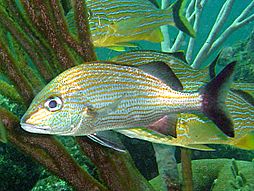fi
nimet breadcrumb-navigoinnissa


Haemulon és un gènere de peixos de la família dels hemúlids i de l'ordre dels perciformes.
Haemulon és un gènere de peixos de la família dels hemúlids i de l'ordre dels perciformes.
Haemulon is a genus of fish in the grunt family known as the scaled-fin grunts. Most are found in the western Atlantic Ocean, with a few species known from the eastern Pacific Ocean.[1] This genus is considered to be one of the most important fish groups of the coral reefs of Brazil due to its commercial value and crucial ecological role.[2]
The 23 or so species in this genus include:[3]
Fish of this genus are oblong in shape and have large mouths.[4] They have scales over the rays of their second dorsal and anal fins, and the second anal spine is larger than the third. The inside of the mouth is usually bright red.[1] Juveniles of the genus look similar to each other, but the variation in the appearance of the adults is great.[5]
Some Haemulon species eat plankton in the open water, but most seek small prey on the seabed.[5] Fish of the grunt family are nocturnal feeders, venturing in schools from the cover of the reefs around sunset to find food. The schools disperse as individuals go hunting, and then reform as morning approaches and they prepare to return to the reef.[6]
Haemulon species are common members of shallow reef fish communities in their range. Their schools can have hundreds[7] or thousands[2] of fish, including adults and juveniles. Schools can be made up of several different Haemulon species;[7] for example, H. squamipinna and H. aurolineatum may associate with each other.[1][7] Haemulon spp. have also been observed in schools with grunts of other genera, such as Anisotremus virginicus, and fish of different families, such as the snapper Lutjanus alexandrei, the goatfish Pseudupeneus maculatus, and the jack Carangoides bartholomaei.[7] Other fish tend to join large Haemulon schools for protection. Sometimes they join a school simply for the protection offered by a large mass of fish, but some species engage in protective mimicry in a school. Unrelated fish that resemble Haemulon in color, size, and shape join the school to hide from predators, even mimicking the swimming style, movements, and postures of the Haemulon. Fish that do this include the goatfish Mulloidichthys martinicus, the parrotfish Sparisoma axillare, and the herring Harengula clupeola.[7] M. martinicus, in particular, stays with groups of its own species while sheltering in the reefs, but when it enters the open water column and becomes visible to predators, it tends to join schools of Haemulon chrysargyreum, which it closely resembles. It assumes the posture of the grunts and blends into the group.[8]
Despite their general preference for close association with other fish, some Haemulon spp. can be territorial and display aggressive behaviors. Larger individuals are more likely to act aggressively, and this behavior is more common at certain times of the day, such as early morning.[2]
Like other members of their family, these fish produce a grunting sound by grinding their pharyngeal teeth, the behavior which inspired their common name.[5]
The spawning behavior of these fish has not been observed.[5]
Haemulon is split by some authorities into two genera, these workers suggest that Haemulon sensu lato is polyphyletic because molecular studies showed that H. chrysargyreum clustered with Xenistius californiensis, rendering Haemulon as polyphyletic if Xenistius was not included.[9] The genus Brachygenys Poey, 1868 was revived to include Xenistius californiensis, Haemulon chrysargyreum, Xenistius peruanus and Xenocys jessiae.[10]
 Haemulon striatum
Haemulon striatum Haemulon carbonarium
Haemulon carbonarium Haemulon flavolineatum
Haemulon flavolineatum Haemulon is a genus of fish in the grunt family known as the scaled-fin grunts. Most are found in the western Atlantic Ocean, with a few species known from the eastern Pacific Ocean. This genus is considered to be one of the most important fish groups of the coral reefs of Brazil due to its commercial value and crucial ecological role.
Los roncos o jeníguanos (género Haemulon) son peces marinos de la familia de los haemúlidos, distribuidos por las costas de América, tanto la costa este del océano Pacífico como la costa oeste del Atlántico.[1]
Tienen el cuerpo esbelto fusiforme y algo comprimido lateralmente, normalmente de coloraciones rayadas llamativas, con una longitud corporal máxima entre los 12 cm de Haemulon squamipinna y los 79 cm del "ronco jallao".[1]
Existen 21 especies válidas en este género:[2]
Los roncos o jeníguanos (género Haemulon) son peces marinos de la familia de los haemúlidos, distribuidos por las costas de América, tanto la costa este del océano Pacífico como la costa oeste del Atlántico.
Tienen el cuerpo esbelto fusiforme y algo comprimido lateralmente, normalmente de coloraciones rayadas llamativas, con una longitud corporal máxima entre los 12 cm de Haemulon squamipinna y los 79 cm del "ronco jallao".
Haemulon est un genre de poissons de la famille des Haemulidae. Ils sont dénommés gorettes.
Selon World Register of Marine Species (2 février 2017)[2] et FishBase (2 février 2017)[3] :
Haemulon est un genre de poissons de la famille des Haemulidae. Ils sont dénommés gorettes.
Haemulon è un genere di pesci ossei appartenenti alla famiglia Haemulidae.
Le dimensioni variano secondo la specie, dagli 11 cm di Haemulon squamipinna agli 80 cm di Haemulon album.
Al genere appartengono 22 specie:
Haemulon è un genere di pesci ossei appartenenti alla famiglia Haemulidae.
Ronkos (lot. Haemulon) – ešerių kriuksių (Haemulidae) šeimos žuvų gentis.
Ronkos (lot. Haemulon) – ešerių kriuksių (Haemulidae) šeimos žuvų gentis.
Haemulon is een geslacht van vissen uit de familie van de Haemulidae in de orde van de Baarsachtigen (Perciformes).
Haemulon is een geslacht van vissen uit de familie van de Haemulidae in de orde van de Baarsachtigen (Perciformes).
Haemulon – rodzaj ryb z rodziny luszczowatych.
Gatunki zaliczane do tego rodzaju [2]:
Haemulon – rodzaj ryb z rodziny luszczowatych.
Este é um gênero da família Haemulidae.
Este é um gênero da família Haemulidae.